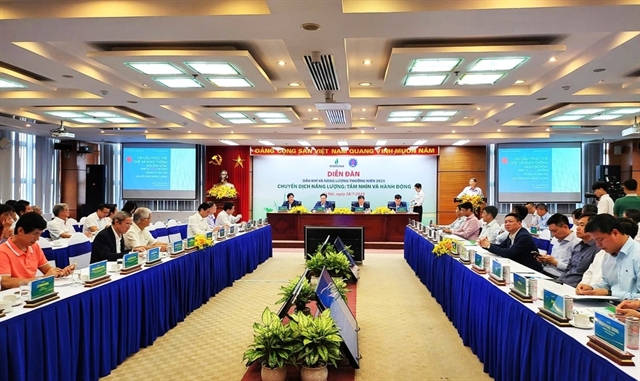Themed 'Energy Transition: Vision and Action', the forum focused on Việt Nam’s need to stay competitive in the global green supply chain while adapting to climate change.

HÀ NỘI — Despite strong political commitment and recent regulatory reforms, Việt Nam continues to face major institutional and financial challenges in its path to net-zero emissions by 2050, as highlighted by experts at the 2025 Annual Oil and Energy Forum held in Hà Nội on Monday.
Themed 'Energy Transition: Vision and Action', the forum focused on Việt Nam’s need to stay competitive in the global green supply chain while adapting to climate change.
Experts acknowledged recent efforts by the Government to revise legal frameworks, such as the 2022 Petroleum Law and the 2024 Electricity Law, along with several new decrees. However, they pointed out that progress remains uneven due to a lack of comprehensive green finance policies, unclear power purchase agreements (PPAs) and electricity pricing mechanisms that do not reflect market conditions.
Three critical issues were repeatedly raised. Electricity tariffs fail to reflect investment risks; PPAs lack clear offtake guarantees or foreign exchange protection; and there is an absence of a regulatory framework for green finance and carbon markets.
Energy economist Ngô Trí Long said that these are not merely technical problems but deeper institutional constraints.
“The current PPA and pricing framework falls short of expectations from international investors. It blocks capital mobilisation from the private sector,” he said.
According to the World Bank, Việt Nam may need over US$135 billion for its energy transition between 2021 and 2030, with around 75 per cent expected to come from the private sector. This poses a major challenge as the legal and financial framework for green energy still faces many obstacles, including project approval processes, guarantee mechanisms, pricing policies and risk-sharing arrangements.
The Vietnam National Industry - Energy Group (Petrovietnam)’s representatives highlighted the difficulties in implementing liquefied natural gas (LNG) projects outlined in Power Development Plan VIII. They cited inconsistencies in infrastructure regulations – from LNG terminals and storage facilities to grid connections – and the lack of government guarantees for foreign loans.
Nguyễn Duy Giang, Deputy General Director of PV Power, shared that his firm had to secure international financing for the Nhơn Trạch 3 and 4 LNG power plants without sovereign guarantees.
“The removal of government guarantees creates serious difficulties not only for us but for many players in the industry,” he said.

The issue of green finance was another major concern. Although Việt Nam has set ambitious climate targets, funding to support these goals remains limited. Currently, only 4.36 per cent of bank credit goes towards green transformation projects.
Nguyễn Đức Hiển, Deputy Head of the Policy and Strategy Department under the Central Economic Commission, emphasised the need to establish green finance institutions and create mechanisms to attract private investment, including public-private partnerships.
“What we have now is not sufficient. To attract the private sector, we must offer better incentives and ensure profitability,” he said.
Hiển suggested a mechanism that allows Petrovietnam to convert its oil and gas assets into carbon assets, thereby unlocking large-scale green capital and shaping a new climate finance model for ASEAN.
Participants offered several recommendations to address the current bottlenecks. These included legalising green finance, establishing investment benchmarks for new energy technologies and designing flexible PPAs tailored to different regions and project types.
They also called for benchmark electricity prices closer to market levels, stronger offtake guarantees for investors, and enhanced coordination through public financial institutions.
The Direct Power Purchase Agreement (DPPA) mechanism, which enables renewable energy producers to sell electricity directly to large consumers, is viewed as a critical policy tool. It would help reduce pressure on Việt Nam Electricity (EVN) while enabling industrial users to access clean, verifiable energy.
“This is particularly important for LNG-to-power projects that require firm, long-term commitments from industrial buyers,” a Petrovietnam official said.
Petrovietnam-affiliated companies also shared their strategies for a green transition. Bình Sơn Refining and Petrochemical (BSR) aims to raise petrochemical output to over 20 per cent by 2030 and expand green product lines. Its emissions reduction roadmap includes four scenarios, with the baseline targeting a 91.6 per cent cut by 2050, requiring an estimated $1.8 billion in investment.
BSR also called for clearer legal provisions on carbon capture, sustainable aviation fuel (SAF), and green credit incentives. Meanwhile, Petrovietnam Exploration and Production Corporation (PVEP) recommended setting emission limits by sector and including emissions clauses in new or renewed petroleum contracts. — VNS





